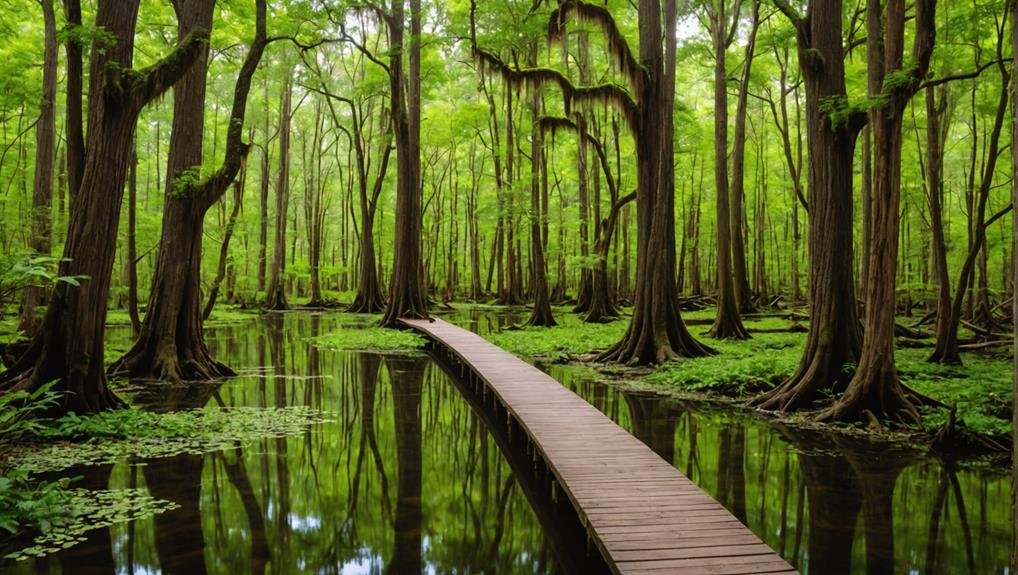Congaree National Park allows you to explore one of the most unique ecosystems in the United States. The park is a haven for biodiversity and recreational activities with its ancient bottomland hardwood forest and dynamic floodplain. You can hike along its extensive trails, paddle through waterways, or camp under the stars.
But have you ever wondered what makes Congaree’s ecosystem so special and how it supports such a wide variety of wildlife? Discover the elements that make this park an essential sanctuary for nature and adventure.
Key Takeaways
- Designated a national monument in 1976 and expanded in 1988 to protect old-growth bottomland hardwood forests.
- Home to over 20 species of champion trees and diverse wildlife, including river otters and bobcats.
- Offers various recreational activities, including hiking, canoeing, kayaking, and camping.
- Nestled in the dynamic Congaree River floodplain, it is essential for sustaining biodiversity through seasonal floods.
- Visitor amenities include a visitor center, educational exhibits, guided tours, and enhanced accessibility by November 2023.
Park History
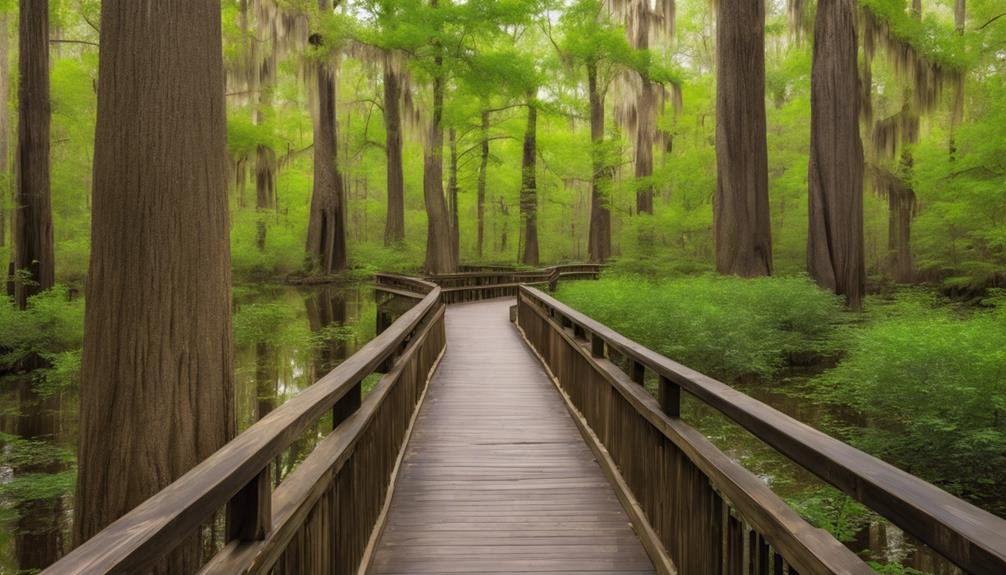
Congaree National Park’s roots trace back to 1976 when it was first designated as a national monument, a significant step towards preserving its unique ecological heritage. Preservation efforts from advocacy groups like the Beidler Forest Preservation Association and Congaree Swamp National Preserve Association largely drove this decision.
These organizations recognized the importance of protecting the area’s rich biodiversity and old-growth bottomland hardwood forest. Before its designation, the region faced extensive resource extraction, particularly cypress logging, which threatened its ecological integrity.
The efforts of dedicated individuals like Harry R. E. Hampton and Peter Manigault were pivotal in advocating for the protection of this natural wonder. Their relentless campaigns highlighted the area’s environmental and cultural value, eventually leading to legislative action.
In 1988, legislation expanded the park, emphasizing its significance as the largest intact expanse of old-growth bottomland hardwood forest in the southeastern United States. This expansion underscored the importance of ongoing preservation efforts to maintain the park’s pristine conditions.
Environmental Features
When you explore Congaree National Park, you’ll discover its impressive champion trees and rich wildlife diversity. This old-growth forest thrives within a dynamic floodplain ecosystem, influenced by the periodic inundation from the Congaree and Wateree Rivers. These environmental features create a unique habitat, making the park an essential ecological treasure.
Champion Trees and Wildlife
Stroll through the awe-inspiring Congaree National Park, and you’ll encounter towering national and state-champion trees that make you feel like you’ve stepped into another world. As you explore, you’ll be surrounded by the tallest known examples of species, like loblolly pine and sweetgum, standing as majestic sentinels within the old-growth bottomland hardwood forest.
This diverse ecosystem is a haven for over 20 species of champion trees, showcasing the park’s rich and varied flora. The diverse wildlife in Congaree National Park adds another layer of enchantment to your visit. You’ll have the chance to spot a variety of mammals, birds, reptiles, and amphibians, including:
- River otters playfully maneuvering the water channels.
- Bobcats stealthily pass through the underbrush.
- The endangered red-cockaded woodpecker finds refuge in the towering trees.
- A myriad of other bird species filled the air with their songs.
These sightings underscore the importance of preserving this unique habitat. The presence of these champion trees and the diverse wildlife they support highlights the critical role the park plays in conservation, offering an unparalleled glimpse into nature’s wonders.
Floodplain Ecosystem Dynamics
Nestled within South Carolina’s Congaree River floodplain, the park’s unique bottomland hardwood forest ecosystem thrives on periodic inundation. These seasonal floods are essential in the floodplain forest, creating a dynamic environment that fosters rich biodiversity.
When the Congaree and Wateree Rivers overflow, they deposit nutrients and sediments, which nourish the soil and sustain ecosystem dynamics. This periodic flooding also supports the growth of national champion trees, which are among the largest and oldest of their species.
These towering giants, including loblolly pines and bald cypresses, benefit immensely from the nutrient influx and sediment deposits. The constant change in water levels also creates diverse habitats, allowing a variety of plants and animals to flourish.
As a UNESCO biosphere reserve and a national natural landmark, Congaree National Park showcases the importance of its floodplain ecosystem dynamics. The continuous interplay between water, soil, and vegetation forms a resilient and adaptive environment.
This dynamic system preserves the largest intact expanse of old-growth bottomland hardwood forest in the southeastern U.S. and highlights how integral these processes are to maintaining ecological balance.
Recreational Activities
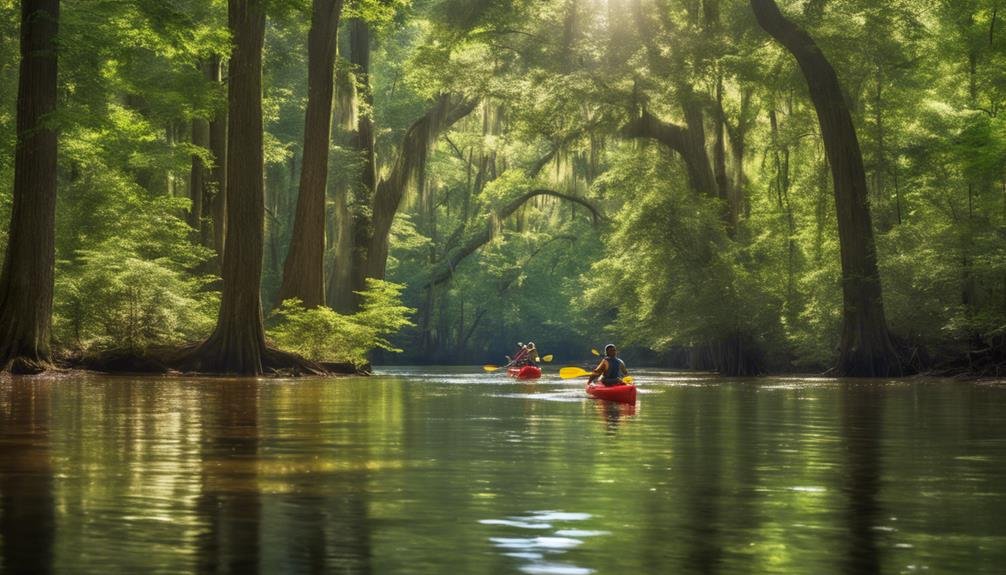
At Congaree National Park, you’ll find many ways to enjoy the great outdoors. Hike along various trails, from easy boardwalk loops to more challenging routes, or paddle through the park’s waterways with canoeing and kayaking adventures. Whether you prefer exploring on foot or by water, the park’s diverse landscape offers something for every nature enthusiast.
Hiking and Nature Trails
Exploring the vast expanse of Congaree National Park offers a unique adventure for hiking enthusiasts and nature lovers. With over 25 miles of marked hiking trails, you’ll find plenty of opportunities for nature exploration and immersion in the park’s pristine wilderness area. Whether you’re trekking through dense forests or traversing boardwalks, each path offers its charm and challenges. Here are some highlights you shouldn’t miss:
- Boardwalk Loop: This accessible trail takes you through a stunning landscape of bald cypress trees, creeks, and diverse wildlife. It’s perfect for a stroll and easy nature exploration.
- Weston Lake Loop Trail: Ideal for bird watchers and those keen on spotting wildlife, this trail offers a mix of boardwalk and natural paths.
- Sims Trail: For a more adventurous experience, hike the Sims Trail, where you’ll tackle rugged terrain and possibly encounter fallen trees and fast-growing plants.
- Bluff Trail: Offering scenic views of the Congaree River, this trail provides a peaceful retreat for those looking to escape deeper into the wilderness.
Be prepared for natural obstacles, but rest assured, the beauty and tranquility of Congaree National Park make every step worthwhile.
Canoeing and Kayaking Adventures
Grab a canoe or kayak and paddle along the 6.6-mile Cedar Creek trail for a thrilling water adventure in Congaree National Park. As you navigate this scenic waterway, you’ll be surrounded by the park’s lush, towering forests. Canoeing here isn’t just about the beauty; it’s also about connecting with the park’s rich history.
Park rangers often lead paddles, providing fascinating insights into Congaree’s natural and historical significance. You’ll hear stories of runaway slaves seeking refuge in the dense forest and the area’s role during Prohibition. These guided tours enrich your paddling experience, making it both educational and exhilarating.
The Cedar Creek trail is filled with natural obstacles, like fallen trees, which add a sense of adventure. Maneuvering around these obstacles ensures that every trip is unique and engaging.
Regularly scheduled paddling opportunities allow you to fully immerse yourself in the serene beauty of Congaree’s waterways. Whether you’re a seasoned paddler or a novice, the combination of history, nature, and adventure on Cedar Creek creates an unforgettable experience. So, don’t miss the chance to explore one of Congaree National Park’s most exciting recreational activities.
Wildlife and Biodiversity
You’ll find extraordinary wildlife and biodiversity amid Congaree National Park’s lush landscapes. The park’s bottomland hardwood forest is an essential habitat for countless species. Witness the rich diversity that thrives within this unique ecosystem. Over 20 mammal species, such as river otters, bobcats, deer, and wild pigs, live in the park.
The forest also hosts over 200 bird species, including woodpeckers and owls, making it a birdwatcher’s paradise. Visitors to Congaree National Park can encounter unique and endangered species, like the red-cockaded woodpecker and the swallow-tailed kite. The barred owl’s call can often echo through the trees, adding to the park’s enchanting atmosphere.
The wetlands within the park teem with life, supporting insects, spiders, and a variety of aquatic creatures. Here’s a glimpse of what you might encounter:
- Birds: Over 200 species, including woodpeckers, owls, and the endangered red-cockaded woodpecker.
- Mammals: River otters, bobcats, deer, and wild pigs.
- Reptiles & Amphibians: Salamanders, snakes, turtles.
- Aquatic Life: Fish, insects, and spiders thrive in the wetlands.
Congaree’s biodiversity is a tribute to its thriving and well-preserved ecosystems.
Trails and Hiking
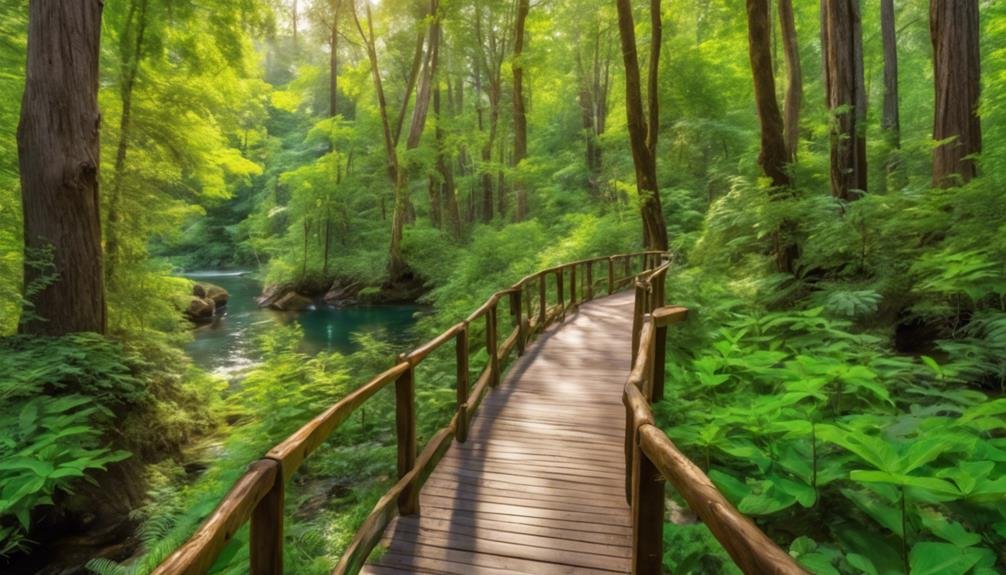
Winding through the heart of Congaree National Park, the boardwalk loop trail offers a mesmerizing journey beneath towering bald cypress trees and alongside serene creeks. It brings you face-to-face with the park’s diverse wildlife. This accessible trail provides a unique perspective of the park’s ecosystem, making it a must-visit for every visitor.
The Sims Trail is a perfect choice for those seeking a bit more adventure. It ventures deeper into the wilderness, giving hikers a more immersive experience. There’s plenty to explore, with approximately 25 miles of marked trails in the park.
As you hike, you’ll likely encounter fallen trees and fast-growing plants, adding to the trails’ natural charm and challenge. The park’s nearly 22,000 acres of designated wilderness area guarantee ample opportunities to appreciate Congaree’s untouched beauty.
Primitive hiking experiences are a highlight, where power tools aren’t allowed. This policy guarantees a serene environment, allowing you to connect with nature fully. Whether you stick to the boardwalk loop or explore the more rugged Sims Trail, Congaree National Park offers an unforgettable hiking experience.
Water-Based Activities
While hiking through Congaree National Park offers an extraordinary land-based adventure, the park’s waterways provide an equally enchanting experience. The 6.6-mile canoe and kayak trail along Cedar Creek is a must-try. You’ll paddle through a serene yet challenging environment filled with natural wonders and occasional obstacles like fallen trees.
For a deeper understanding of the park’s history and ecology, join one of the park ranger-led paddles. These guided tours offer incredible insights into the area’s historical significance and natural beauty. You’ll learn about the history of runaway slaves who found refuge here and the intriguing tales from the Prohibition era. Here are some top water-based activities you can enjoy:
- Canoeing and Kayaking: Explore Cedar Creek’s scenic route alone or with friends.
- Park Ranger-Led Paddles: Gain historical and natural insights from knowledgeable guides.
- Wildlife Watching: Spot diverse species of birds, amphibians, and other wildlife from your canoe or kayak.
- Photography: Capture stunning photos of the lush, watery landscapes and unique obstacles like fallen trees.
Whether you’re paddling solo or joining a guided tour, Congaree National Park’s waterways promise a unique and enriching experience.
Camping Options
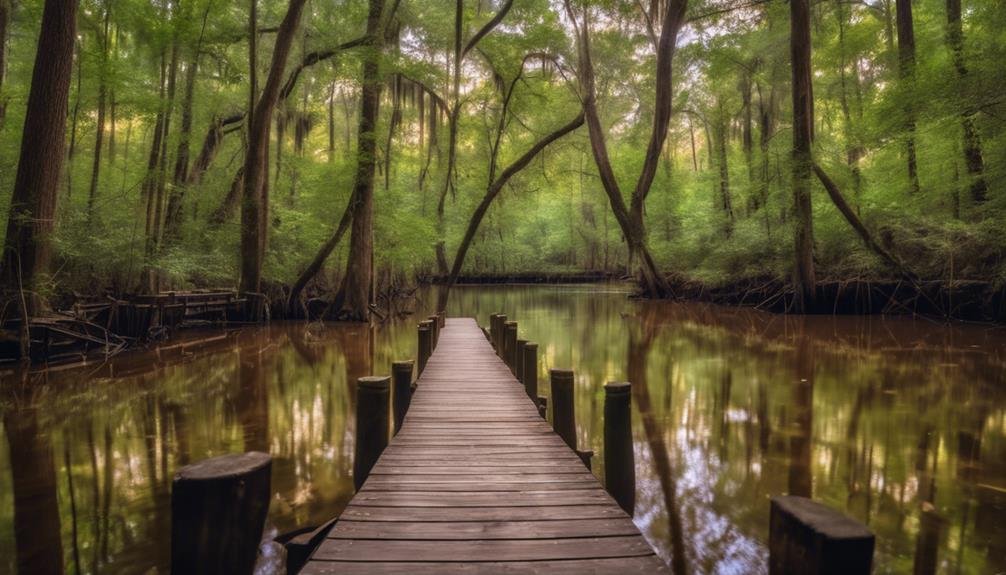
Camping in Congaree National Park offers a profound connection to nature that’s hard to find elsewhere. With various camping options, you can choose the experience that best suits your adventure style. For a truly immersive wilderness experience, try the free camping spots along the riverbank.
These scenic locations offer breathtaking views, particularly along the Weston Lake Loop and River Trail. If you prefer a more traditional setup, head to the high-ground campground, where you’ll find fire pits and designated camping areas. This spot is perfect for those who enjoy a bit more structure while still surrounded by nature.
The Bates Ferry Trail provides easy access to the Congaree River, making it an ideal choice for campers who want to combine hiking with water-based activities. Here’s a quick comparison to help you visualize your options:
| Feature | Option 1: Riverbank Camping | Option 2: High-Ground Campground |
|---|---|---|
| Cost | Free | Free |
| Scenic Views | Weston Lake Loop, River Trail | High ground with fire pits |
| Hiking Access | River Trail | Bates Ferry Trail |
| Water Access | Close to river | Easy access via Bates Ferry Trail |
| Camping Setup | Primitive | Traditional |
No matter your choice, camping in Congaree guarantees you’ll experience the park’s dynamic, picturesque setting.
Visitor Amenities
When you visit Congaree National Park, stop by the Visitor Center, where you’ll find informative displays and helpful resources. For those seeking adventure, the park offers both primitive and backcountry camping options and trails for hiking, canoeing, and bird-watching. Don’t miss the accessible raised platform trails, which let everyone appreciate the park’s natural beauty.
Visitor Center Highlights
At the Visitor Center at Congaree National Park, you’ll find many resources to enhance your visit, from informative displays on the park’s natural features and history to detailed guides on trails, wildlife, and regulations. The Visitor Center is an essential hub for gathering all the information you need before starting your adventure through the park.
The exhibits are designed to be engaging and educational, offering interactive displays that captivate visitors of all ages. You can explore the park’s rich history, understand the diverse ecosystems, and learn about the unique flora and fauna that call Congaree home. Park rangers and volunteers are always on hand to provide valuable insights and answer any questions you might have. Here are four highlights you shouldn’t miss:
- Educational Exhibits: Gain a deeper understanding of the park’s natural wonders and cultural history.
- Trail Guides: Pick up detailed maps and guides to navigate the various trails.
- Interactive Displays: Engage with hands-on exhibits that make learning enjoyable for everyone.
- Guided Tours: Join ranger-led programs to explore the park with expert guidance.
Make the Visitor Center your first stop to make sure you make the most of your visit to Congaree National Park.
Camping and Trail Options
Among the many attractions at Congaree National Park, exploring the extensive camping and trail options can be one of the most rewarding experiences. You’ll find various camping options, from free riverbank spots to more developed areas. The high-ground campground offers fire pits and designated sites for those who prefer a comfortable setting.
This setup guarantees you can enjoy the wilderness area without sacrificing comfort. If you’re an adventurer, consider camping along the scenic Weston Lake Loop or River Trail. These spots provide an immersive experience under the park’s tall canopy, which changes beautifully with the seasons. The nearly 22,000 acres of wilderness area ensures there’s always something new to discover.
For hiking enthusiasts, the Bates Ferry Trail is a must-do. This short hike takes you to the Congaree River, offering a glimpse of the park’s diverse landscapes. Whether you’re looking for a brief stroll or a challenging trek, the park’s hiking trails accommodate all levels of hikers. In Congaree National Park, every camping and hiking experience is unique, making each visit an unforgettable adventure in nature’s lap.
Safety Guidelines
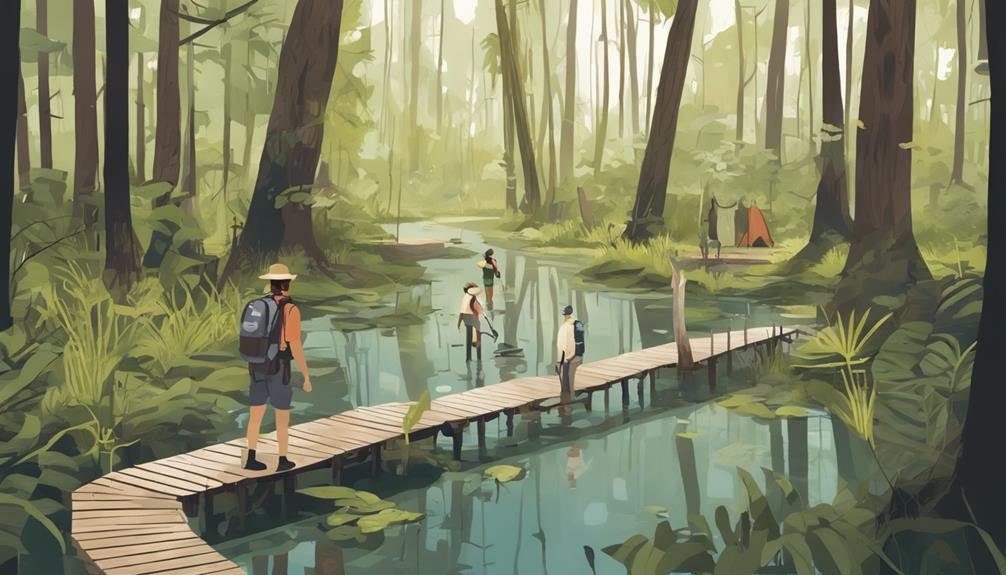
Before heading to Congaree National Park, it’s vital to check the weather conditions to stay prepared for occasional flooding due to heavy rainfall. This beautiful hardwood forest can quickly become hazardous during heavy rains, so staying informed is crucial. Following safety guidelines will help guarantee a safe and enjoyable visit.
- Check Trail Status: Some trails may be closed or unsafe during flooding. Verify the status of your chosen trail before setting out to avoid unexpected hazards.
- Pack Essentials: Bring plenty of water and sunscreen. The park’s vast expanses mean you’ll be exposed to the sun for extended periods, making hydration and skin protection essential.
- Respect Wildlife: Alligators inhabit the swamp areas of the park. Always keep a safe distance and never attempt to feed or approach them. Respecting wildlife ensures both your safety and the animals.
- Dispose of Trash Properly: Properly dispose of all trash to maintain the park’s natural beauty. This helps protect the ecosystem and keeps the environment safe for everyone.
Accessibility Resources
While following safety guidelines secures a safe visit, Congaree National Park also enhances its accessibility resources to make every visitor’s experience more inclusive. Accessibility enhancements at the National Park are set to be completed by November 14, 2023, aiming to create a more welcoming environment for visitors with disabilities.
These significant improvements guarantee that all park areas are accessible to everyone. Whether exploring the lush landscapes or participating in recreational activities, the enhancements will make it easier for all visitors to enjoy the park’s natural beauty.
The project focuses on making trails, facilities, and viewing areas more navigable for individuals with mobility issues, enhancing the overall visitor experience. With these updates, Congaree National Park is committed to offering an inclusive experience. The improved accessibility will benefit disabled visitors and make it convenient for families with strollers and elderly visitors.
Frequently Asked Questions
Is It Worth Going to Congaree National Park?
It’s worth it! You’ll experience a unique ecosystem, engage in various outdoor activities like hiking and kayaking, and enjoy incredible wildlife spotting opportunities. The park’s rich biodiversity and old-growth forest make it a must-visit destination.
How Much Time Do You Need at Congaree National Park?
You’ll need a full day to enjoy the best activities, including hiking, canoeing, and fishing. An ideal visit length ensures a memorable experience by allowing you to see must-see sights and participate in ranger-led programs.
Does It Cost to Enter Congaree National Park?
You don’t need to worry about park fees. There’s no cost to enter and explore. The visitor center and all trails are free. You won’t need an annual pass to enjoy everything the park offers.
Can You Stay at Congaree National Park?
You can stay with various camping options, including primitive sites and established campgrounds. If you prefer more comfort, consider lodging nearby. Day trips are also a great way to explore without staying overnight.
Conclusion
Congaree National Park is a true gem, offering both adventure and tranquility. With its rich history, diverse wildlife, and myriad recreational activities, it’s a must-visit for nature lovers. Hike the trails, paddle through serene waterways, or camp under the stars. Remember to follow safety guidelines and take advantage of the park’s amenities and accessibility resources. Your visit to Congaree promises unforgettable memories and a deep appreciation for this natural wonder.
Explore More Articles:
Tagthings to Do in Maggie Valley NC: Your Ultimate Itinerary
Ireland the Best 7-Day Road Trip Itinerary: Explore the Emerald Isle
See Holiday Lights in Asheville: Top Spots for a Magical Experience
